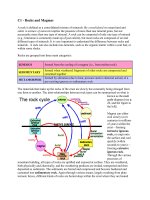ch05 sedimentary rocks online notes
Bạn đang xem bản rút gọn của tài liệu. Xem và tải ngay bản đầy đủ của tài liệu tại đây (8.79 MB, 63 trang )
Sediments and Sedimentary
Rocks
Chapter 5
•
•
•
•
•
•
•
•
•
•
•
•
Concepts you will need to know for the
exams
Weathering
Erosion
Transportation
Sorting
Angularity
Sedimentary environments,
Cross-bedding (sedimentary structures)
Bioturbation, bedding sequences, diagenesis
Classes of sediments and sedimentary rock:
-based on grain size
-based on chemical composition, e.g.,
carbonate rocks ("carbonates") and evaporitic rocks
("evaporites")
Lecture Outline
1. Sedimentary rocks
2. Your sedimentary environment and Burial
and diagenesis
3. Interpretation of clastic texture
4. Sedimentary structures
5. Sedimentary Rock classification
1. Sedimentary Rocks
•Cover most of the land surface and
seafloor
•Your physical geography determines the
dominant process at work in the
sedimentary rock cycle
•e.g. (1) Mountains => weathering and/or
erosion
•e.g., (2) Southern Louisiana =>
•e.g., (3) offshore Louisiana =>
1. Sedimentary Rocks
•Cover most of the land surface and
seafloor
•Your physical geography determines the
dominant process at work in the
sedimentary rock cycle
•e.g. (1) Mountains => weathering and/or
erosion
•e.g., (2) Southern Louisiana =>
transportation or deposition or erosion
•e.g., (3) offshore Louisiana =>
1. Sedimentary Rocks
•Cover most of the land surface and
seafloor
•Your physical geography determines the
dominant process at work in the
sedimentary rock cycle
•e.g. (1) Mountains => weathering and/or
erosion
•e.g., (2) Southern Louisiana =>
transportation or deposition or erosion
•e.g., (3) offshore Louisiana => erosion or
sedimentation
erosion
weathering
transportation
Erosion includes BOTH weathering and transportation
Sedimentary rocks are typically
layered, (although layering is not
diagnostic of only sedimentary rocks)
Lecture Outline
1. Sedimentary rocks; surface processes
2. Your sedimentary environment and Burial
and diagenesis
3. Interpretation of clastic texture
4. Sedimentary structures
5. Sedimentary Rock classification
A sedimentary environment is a
geographic location that has a
peculiar combination of geological
processes
Walther’s Rule (1894)
“The different (sedimentary) rocks
(types) were formed beside each
other in space, but in a crustal profile
we see them lying on top of each
other….”
Bedding sequences--are successions of rock ( in
a vertical profile) that help
geologists work out the
past environment
Where do you live?
•What dominant
sedimentary process is at
work where you live?
If deposition is the dominant process, e.g.,
offshore Lousiana then rocks are in the
process of being formed:
Diagnesis includes
(1) compaction = volume loss (mechanical
squeezing)
and is accompanied by dewatering (= water
loss) (by chemical or physical means)
(2) changes in mineral composition (chemical
process with heat and or fluids)
(3) cementation (physical)
If a sediment eventually becomes a rock we
say it is lithified.
lithified
DIAGENESIS
compaction
DIAGENESIS
compaction
dewatering
DIAGENESIS
compaction
dewatering
Cementation &
mineral
changes
Lecture Outline
1. Sedimentary rocks; surface processes
2. Your sedimentary environment and Burial
and diagenesis
3. Interpretation of clastic texture
4. Sedimentary structures
5. Chemical and biological classification
Geological FUZZY rules
for determining degree of
weathering and transport a
rock or sediment has
experienced respectively









